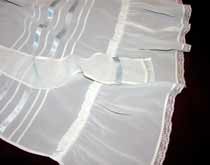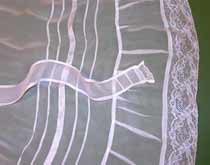Sewing Part 1 Sewing Part 2 Sewing Part 3 Sewing Part 4
Sewing Guidelines for a Doukhobor “Zanaveska” Apron
Florence Swetlikoff, Helen Poohachoff’s daughter, loaned her mother’s “zanaveska” to the CIS for the purpose of developing instructions for this unique apron. Helen Poohachoff married in 1925 wearing a woolen zanaveska but after sheer fabrics became fashionable, she designed and sewed a decorative zanaveska to complement her Doukhobor ensembles.



Zanaveski are referred to as aprons, however, there is a distinct difference between them. The long, solid colored zanaveski of the pioneer Doukhobor women were used as a covering for the skirt. The dark fabric, woolen and cotton, were durable and were used for practical utilitarian purposes. The more colorful woolens with trims of knitted or crocheted edgings were prepared for bridal ensembles. As sheers, taffetas and other silky fabrics became fashionable, Doukhobor women sewed beautiful zanaveski to complement their “Sunday best” outfits. Today, a zanaveska is sewn from a sheer fabric and embellished with ribbons and lace and used only as a costume piece for stage performances.
Fabric:
- 1 ½ m of sheer fabric. White is most popular but color may be coordinated to match the skirt.
-
Lace – 1 ½ metres of 2 ½ - 3 inch wide lace (or preferred width)
-
Ribbon – 1 ½ metres of ¾ inch wide ribbon
Note: The length of the zanaveska is determined by the height of the individual and the length of the skirt that the zanaveska will complement. The zanaveska traditionally is 3 – 5 inches shorter than the skirt. Also, the length of the waistband is determined by the individual’s waist measurement. Traditionally, the width of the finished zanaveska did not extend over the hips but was used as a decoration for the front of the Doukhobor ensemble. Waist ties can also be wider.
Instructions based on sewn zanaveska:
-
Preshrink fabric, dry and press.
-
Cut or rip the fabric to a 43 inch width by 22 inch length (add extra length to allow for the number of rows of pin tucks)
-
Cut or rip 2 waist ties, 24 inches long by 3 inches wide. Sew a ribbon about 2 ½ inches from the end of each tie. Hem the end and sew on a piece of lace at the end.
-
Hem the lengths by folding twice to make a ¼ inch seam.
-
Cut or rip fabric for the waist band, 24 ½ inches long and 1 – 1 ½ inches wide (finished waistband is ¼ to 3/8 inch wide)
-
At 13 ½ inches down from the top of the “zanaveska” sew 3 rows of ¼” pleats (pin tucks) ½” apart across the width of the zanaveska.
-
Sew the ¾” ribbon across the width, ½” down from the last pleat.
-
Sew 3 more pleats (pin tucks) ½ inch down from the ribbon.
-
Hem the main piece of the zanaveska with a ½ inch hem before attaching the ruffle.
-
Cut or rip a 50 inch length and 6 ½ inch width strip of fabric for the bottom ruffle. Finish lower edge of ruffle with a ¼ inch hem. The finished ruffle including the attached lace and header is approx. 8 ½ inches so width of ruffle needs to be adjusted if using a wider lace.
-
Sew lace to the bottom of the ruffle.
-
Hem the top edge of the ruffle – the header with a 5/8 inch hem.
-
Gather the header ½ inch from the top to fit the 43” width of the zanaveska and sew on to the hem along the header hem stitch line so that the upper gathers of the ruffle are about ½ inch over the body of the “zanaveska”.
-
Narrow hem the two side edges of the “zanaveska”.
-
Gather the waist of the zanaveska to 18 ½ inches.
-
Attach the ties to the waistband by folding in the wider ties into the ends of the waistband. The narrow waistband extends 3 inches on each side of gathered zanaveska at which point the ties are attached.
-
Centre the gathers into the waistband. Sew the waistband on to the zanaveska, right side of waistband to wrong side of the gathered zanaveska and then fold over and sew from the front. The front waistband has the stitching neatly showing.
A different sequence of pin tucks and a variety of ribbons and laces were used to make each zanaveska a unique treasure!
To Previous Page in This Section

